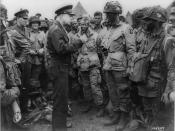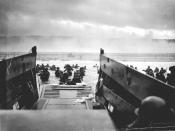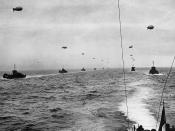The Normandy Invasion
World War II was in full swing, but the end was drawing near. On the sixth day of June 1944, the American forces stormed the coast of Normandy in northern France. To fully understand the Normandy invasion one must know about the buildup, the invasion, and the effects.
Hitler's Third Reich had reached its greatest extent. The allies pondered ways of turning the tide. It was midsummer of 1943, one year before the Normandy invasion and the liberation of Western Europe, which Hitler's forces still occupied (Normandy 1944). Russian counteroffensives at Stalingrad and Kursk held back Hitler's perimeter. Although the American war economy had begun to overshadow Germany's, the Nazi war economy outmatched both that of Great Britain's and the Soviet Union (Normandy 1944). Joseph Stalin, the Soviet leader, pressed his allies, U.S. president Franklin D. Roosevelt and British Prime Minister Winston Churchill to mount a "second front".
The American army was still forming and the landing craft necessary to take an army across the English Channel had not yet been built. On December 11, 1941, Hitler declared war on the United States. George C. Marshall, Roosevelt's chief of staff, appointed Dwight D. Eisenhower to the U.S. war plans division and commissioned him to design an operational scheme for an allied victory (Normandy Invasion 456). Two proposals Eisenhower formed were Operations Roundup and Sledgehammer (Normandy 1944). Although both plans were presented to the British, Operation Roundup was adopted. A series of conferences were held in Washington and London in June and July. The allies threw out Operation Sledgehammer and persuaded the Americans to agree to a North American landing codenamed Operation Torch. Operations in Sicily and on the Italian mainland delayed allied preparations through 1943 (Normandy 1944). At...


